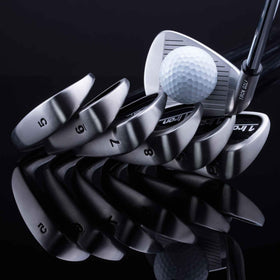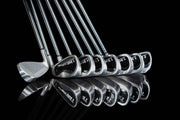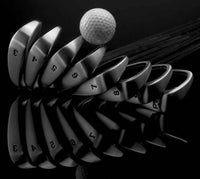Conventional versus Single-Length Golf Clubs
by David Lake
I am constantly amazed when golfers boast about their conventional sets of irons being “custom fitted” and, therefore, producing enhanced and consistent performance. The concept of being “custom fitted” for a set of conventional golf clubs is ridiculous in that you still end up with 13 clubs (excluding the putter) of different lengths, weights, shaft flexes, lie angles, bounce angles, offsets, etc. when, in fact, your body gravitates to only one efficient movement for any physical endeavor (that is the reason why all golfers have a “favorite” iron). Therefore, after being “custom fitted” for a set of conventional clubs you still end up having only one iron in your bag that even comes close to fitting you correctly and that somewhat allows for the swing posture and swing movement that your body wants to make when hitting a ball with a golf club. As far as consistent performance goes I have to bite my tongue. The following table shows the typical specifications for a conventional set of irons (varies between brands as there are no specification standards in the golf industry).

How this equates to consistency I do not know. I would like to point out something from the above table that most golfers do not realize and that has to do with the varying shaft flexes within a set of conventional irons. Regardless of what the shaft bands state, every one of the irons in a conventional set has a different shaft flex that gets progressively stiffer from the #3 iron to the wedges. To prove this to yourself simply hold the clubhead of a conventional #3 iron in one hand with the grip in the other hand and bend it – then do the same thing with the PW from the same set and you will see what I mean.
Another thing that most golfers do not realize is that in a conventional set of irons the clubhead weight progressively increases from the #3 iron through the wedges. This results in a greater amount of mass impacting the golf ball with the wedges than the low lofted irons. Wouldn’t you want the higher impact mass associated with the iron that is designed to produce the most distance? Enhanced and consistent performance? – Go figure.
The specifications for a set of 1 Iron single length irons are shown below. With the exception of the bounce angle on our SW the only difference between irons is the exact 4º loft angle progression from the #3 iron through the wedges. The reason for the additional 3º of bounce angle on the SW is to enhance play from a soft bunker. You may note that the bounce angle of a typical conventional SW varies from 10º to 14º. Bounce angles this high produce a clunky shot out of the sand and make playing shots from a close cut fairway virtually impossible. What is sad is that most golfers will continually blade shots out of the fairway with a conventional SW without ever even understanding why. Our 1 Iron single length SW was designed for highly effective sand play as well as fairway play, and an interesting point is that part of my design testing for our SW involved hitting balls off of a cement driveway (no skulled shots with our SW).

At the end of the day you just have to leave all of the marketing hype about custom fitting and conventional golf club design behind and simply rely on plain old common sense.










